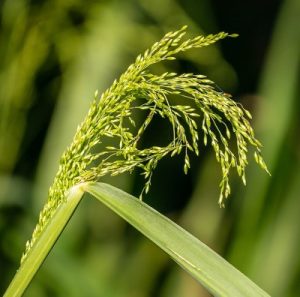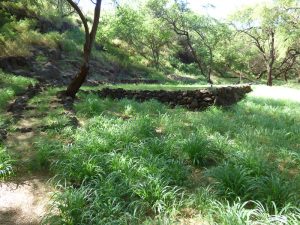GUINEA GRASS (Megathyrsus maximus)
Synonym: Panicum maximum
Hawai‘i-Pacific Weed Risk Assessment Score: 17 (High Risk). Visit Plant Pono for more information.
information.
Weed Fire Risk Score = 0.89 (This species is likely a high fire risk in Hawai’i); Visit Pacific Fire Exchange Weed Risk Assessments for more information
Regulatory Status: None
Prevention and Control Category: N/A
Description
- Shade tolerant perennial, grows in dense bunches, up to 9 ft tall, hairy or not, but densely hairy at nodes. Sheaths hairy or not except densely hairy at collar. Ligules very short fringed membrane. Leaves up to 3 ft long by 1 inch wide. Inflorescences open panicles, capable of producing 9000 seeds per plant. Germination rate is low unless the seeds are stored dry for 6 months or more. Seed produced asexually (apomictic), hence local populations tend to be genetically uniform.
- Native to Africa, an important forage grass, widely introduced and naturalized throughout the tropics.
Impacts
- Strong allelopathic activity.
- Forms dense stands in unmanaged areas.
- Increases fire risk in unmanaged or ungrazed landscapes, and during periods of drought.
- Regenerates rapidly following fire, and can expand into burned areas.
- Seeds dispersed by wind, and in animal droppings.
Uses
- An important forage grass.
Distribution
Naturalized and common, 0-850 m, on all of the main Hawaiian islands. Cultivated and probably found growing in the wild prior to 1871.
